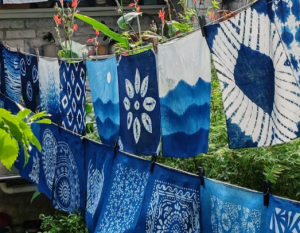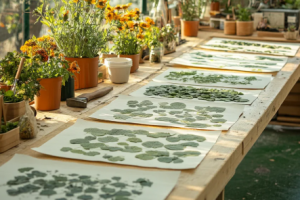A plain bamboo frame, a spread of fine paper—in the hands of a master artisan, these elements transform into the enduring cultural legacy of the Jinling folding fan.
“As white as jade, as smooth as a mirror, as thin as a cicada’s wing.” These words capture the essence of the Jinling folding fan. At the Nanjing Jinling Folding Fan Craft Research Institute, Ni Shijin, the director in his sixties, gently opens a bamboo folding fan with focused eyes and deep affection.
The fan’s ribs, warm and polished, resemble the demeanor of a noble scholar, while its surface unfolds like a landscape painting. This seemingly unassuming fan carries six hundred years of cultural elegance from Jinling, the ancient capital now known as Nanjing.
01 An Imperial Artifact: The Historical Origins of the Jinling Folding Fan
The origins of the Jinling folding fan can be traced back to the Song and Yuan dynasties. Historical records indicate that fan production in Nanjing had already begun to take shape during this period. However, it was Emperor Zhu Di of the Ming Dynasty who truly elevated its status.
After ascending the throne in Nanjing, Zhu Di encountered folding fans and was captivated by their convenience and elegance. He ordered palace artisans to refine their craftsmanship, incorporating techniques from abroad.
From then on, bamboo folding fans “spread from the palace to the world,” transitioning from imperial luxury to popular accessory.
During the Ming and Qing dynasties, the Jinling folding fan reached its zenith. As Nanjing served as the cultural and examination hub of southern China, scholars flocked to the city for imperial exams. They would often purchase finely crafted folding fans near the Confucius Temple, using them as symbols of scholarly refinement.
These fans were later brought back to their hometowns, inscribed with poems or paintings, or given as gifts, further cementing their status as cultural icons.
The Qing scholar Gan Xi, in his book Notes from Nanjing, praised Jinling folding fans for their “smooth polish and pristine paper,” noting that “buyers from afar sought them at premium prices.” The area along the Qinhuai River, known as “Fan Rib Lane,” became the center of fan production, a name that persists to this day.
02 Masterful Craftsmanship: The Unique Techniques of Jinling Folding Fans
Ranked among China’s “Four Great Fans” (alongside Suzhou sandalwood fans, Zhejiang black paper fans, and Guangdong palm leaf fans), the Jinling folding fan is celebrated for its exquisite materials and intricate carving techniques.
Artisans often use precious materials such as ivory, tortoiseshell, and rosewood for the fan ribs, engraving delicate patterns onto the edges. The fan heads come in various shapes, including the “Ruyi head,” “Lyre-style,” and “Mantis Leg,” each reflecting a distinct aesthetic.
The most remarkable technique is the “Shuimo Jade-like Bamboo” process. Bamboo aged six to eight years is selected, boiled to remove proteins and sugars (preventing insect damage), and then left to dry naturally.
The most labor-intensive step, “blade edging,” involves meticulously shaping the fan’s edges with a knife. To ensure the fan opens and closes smoothly, the ribs are carefully heated and bent into a perfect curve through a process called “fire shaping.”
The fan surface, typically made of Xuan paper, undergoes multiple steps including selection, cutting, mounting, edging, and folding. Xuan paper is preferred for its durability—a saying goes, “Xuan paper lasts a thousand years, while silk decays like rotten grass.”
The folding step is particularly critical, as each pleat must align perfectly with the fan’s center to ensure seamless operation.
03 Rise and Fall: The Modern Challenges of Jinling Folding Fans
In the late Qing and early Republican periods, Jinling folding fans remained highly popular. Historical records show that annual sales reached a million units, distributed across the country. Artisans in areas like Qixia and Longtan formed the backbone of the industry, as reflected in the folk rhyme, “After the Double Ninth Festival, fan-making never leaves hand.”
In the 1950s, the government organized scattered artisans into collective workshops, eventually establishing the Nanjing Jinling Fan Factory in the 1960s. The fans became important export products, with the first batch of 3,600 silk fans for women shipped abroad in 1964.
The 1980s marked the factory’s golden age, with large decorative fans sold to Southeast Asia, reaching annual exports of 15,000 units.
However, with the popularization of electric fans and air conditioners, coupled with management difficulties, the Jinling folding fan gradually lost its market. In 2002, the Jinling Fan Factory closed its doors, and the six-century-old craft faced the risk of extinction.
04 A New Lease on Life: The Revival of Jinling Folding Fans
A turning point came with the growing movement to preserve intangible cultural heritage. In 2008, Jinling folding fan craftsmanship was recognized as a Nanjing municipal intangible cultural heritage, and in 2009, it was elevated to provincial-level status.
That same year, the Nanjing Jinling Folding Fan Craft Research Institute was established, becoming the sole institution dedicated to preserving this legacy.
The institute brought together 12 veteran artisans from the original fan factory, who resumed the traditional production process under Director Ni Shijin’s leadership.
Today, the institute not only produces classic Shuimo jade-like bamboo fans and rosewood fans but also innovates with new designs such as “gold-leaf fans,” “Rainflower Stone fans,” and “paper-cut fans,” infusing traditional craftsmanship with contemporary relevance.
In 2015, Jinling folding fans were featured at the Milan Expo in Italy, showcasing over a dozen varieties to an international audience. The following year, they earned praise from Prince William during the “Nanjing Week” event at the London Design Festival.
05 A Symbol of Culture: The Deeper Meaning of Jinling Folding Fans
Beyond their practical use, Jinling folding fans have become enduring symbols of Chinese culture. They integrate bamboo craftsmanship, carving, and painting into a single art form, embodying the essence of traditional Chinese aesthetics.
In literary classics such as The Peach Blossom Fan and Dream of the Red Chamber, folding fans serve not only as props but also as pivotal elements driving the narrative. In The Peach Blossom Fan, the fan carries the tragic love story of Hou Fangyu and Li Xiangjun, mirroring the rise and fall of an era.
Jinling folding fans are also closely associated with Nanjing bamboo carving. During the mid-Ming Dynasty, masters like Li Zhao and Pu Zhongqian pioneered the Nanjing style of bamboo carving, characterized by minimal polishing and subtle engraving. Their works are now treasured in museums such as the Palace Museum and the Nanjing Museum.
To this day, the artisans at the research institute uphold the spirit of “pursuing excellence without seeking reward.” The twelve masters produce only ten fans per day, each infused with a lifetime of skill and dedication.
At the Nanjing Jinling Folding Fan Craft Research Institute, Ni Shijin and his colleagues continue to safeguard this heritage. The oldest among them is 78, the youngest 56. They work tirelessly, not for profit, but to ensure that this six-century-old craft endures.
“We should not be phased out by technological progress but should evolve alongside the elevation of the Chinese nation’s artistic and cultural cultivation,” says Ni Shijin, his gaze steady and resolute.
The Jinling folding fan, a cooling breeze spanning six hundred summers, now continues its journey, sharing the story of Chinese artisans’ perseverance and innovation with the world.
猜你喜欢
发表评论
电子邮件地址不会被公开。 必填项已用*标注







